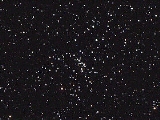
Messier 48
Encyclopedia
Messier 48 is an open cluster
in the Hydra constellation. It was discovered by Charles Messier
in 1771.
There is actually no cluster in the position indicated by Messier. The value that he gave for the right ascension
matches that of NGC 2548, however, his declination
is off by five degrees.
Credit for discovery is sometimes given instead to Caroline Herschel
in 1783.
M48 is visible to the naked eye
under good atmospheric conditions. Its age is estimated to amount 300 million years.
Open cluster
An open cluster is a group of up to a few thousand stars that were formed from the same giant molecular cloud and have roughly the same age. More than 1,100 open clusters have been discovered within the Milky Way Galaxy, and many more are thought to exist...
in the Hydra constellation. It was discovered by Charles Messier
Charles Messier
Charles Messier was a French astronomer most notable for publishing an astronomical catalogue consisting of deep sky objects such as nebulae and star clusters that came to be known as the 110 "Messier objects"...
in 1771.
There is actually no cluster in the position indicated by Messier. The value that he gave for the right ascension
Right ascension
Right ascension is the astronomical term for one of the two coordinates of a point on the celestial sphere when using the equatorial coordinate system. The other coordinate is the declination.-Explanation:...
matches that of NGC 2548, however, his declination
Declination
In astronomy, declination is one of the two coordinates of the equatorial coordinate system, the other being either right ascension or hour angle. Declination in astronomy is comparable to geographic latitude, but projected onto the celestial sphere. Declination is measured in degrees north and...
is off by five degrees.
Credit for discovery is sometimes given instead to Caroline Herschel
Caroline Herschel
Caroline Lucretia Herschel was a German-British astronomer, the sister of astronomer Sir Friedrich Wilhelm Herschel with whom she worked throughout both of their careers. Her most significant contribution to astronomy was the discovery of several comets and in particular the periodic comet...
in 1783.
M48 is visible to the naked eye
Naked eye
The naked eye is a figure of speech referring to human visual perception unaided by a magnifying or light-collecting optical device, such as a telescope or microscope. Vision corrected to normal acuity using corrective lenses is considered "naked"...
under good atmospheric conditions. Its age is estimated to amount 300 million years.

